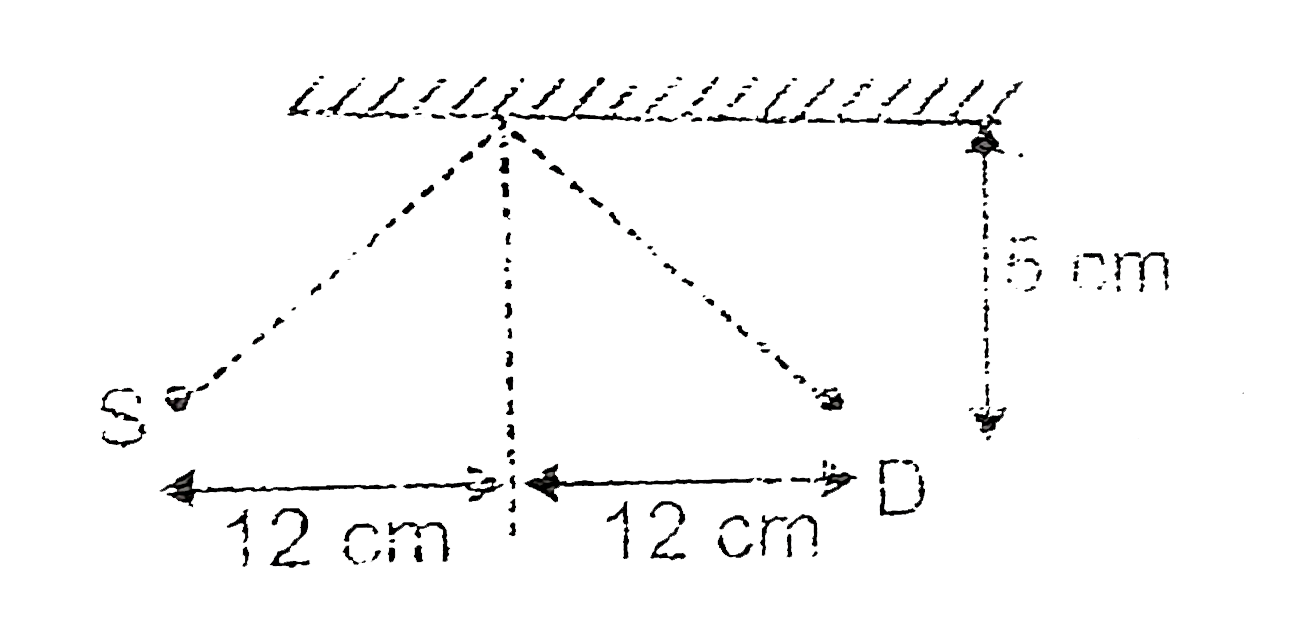When a sound wave is reflected from a wall the phase difference between the reflected and incident pressure wave is:
0
π
π/2
π/4
The correct Answer is:A
To solve the question regarding the phase difference between the reflected and incident pressure wave when a sound wave is reflected from a wall, we can follow these steps:
1. Understanding the Reflection of Sound Waves:
- When a sound wave encounters a rigid boundary (like a wall), it reflects back. The behavior of the wave at this boundary is crucial to determining the phase difference.
2. Behavior at a Rigid Boundary:
- At a rigid boundary, the particles of the medium cannot vibrate. This means that the wave reflects in such a way that it creates a node at the boundary. A node is a point where there is zero displacement of the medium.
3. Interference of Waves:
- The incident wave and the reflected wave interfere with each other. At the boundary, where the wave reflects, the condition for constructive interference leads to a situation where the pressure variation is maximized.
4. Phase of Reflected Wave:
- The reflected wave maintains the same phase as the incident wave because the pressure variation is maximum at the boundary. This means that the peaks and troughs of the reflected wave align with those of the incident wave.
5. Calculating Phase Difference:
- Since the reflected wave has the same phase as the incident wave, the phase difference between the two waves is zero.
6. Conclusion:
- Therefore, the phase difference between the reflected and incident pressure wave when a sound wave is reflected from a wall is 0 radians.
Final Answer:
The phase difference between the reflected and incident pressure wave is 0 radians.
- When a sound wave encounters a rigid boundary (like a wall), it reflects back. The behavior of the wave at this boundary is crucial to determining the phase difference.
- At a rigid boundary, the particles of the medium cannot vibrate. This means that the wave reflects in such a way that it creates a node at the boundary. A node is a point where there is zero displacement of the medium.
- The incident wave and the reflected wave interfere with each other. At the boundary, where the wave reflects, the condition for constructive interference leads to a situation where the pressure variation is maximized.
- The reflected wave maintains the same phase as the incident wave because the pressure variation is maximum at the boundary. This means that the peaks and troughs of the reflected wave align with those of the incident wave.
- Since the reflected wave has the same phase as the incident wave, the phase difference between the two waves is zero.
- Therefore, the phase difference between the reflected and incident pressure wave when a sound wave is reflected from a wall is 0 radians.
The phase difference between the reflected and incident pressure wave is 0 radians.
Topper's Solved these Questions
- SOUND WAVESBOOK - RESONANCE ENGLISHCHAPTER - SOUND WAVESEXERCISE - Exercise- 2 PART - I
24 Videos
- SOUND WAVESBOOK - RESONANCE ENGLISHCHAPTER - SOUND WAVESEXERCISE - Exercise- 2 PART - II
20 Videos
- SOUND WAVESBOOK - RESONANCE ENGLISHCHAPTER - SOUND WAVESEXERCISE - Exercise- 1 PART - I
34 Videos
- SIMPLE HARMONIC MOTIONBOOK - RESONANCE ENGLISHCHAPTER - SIMPLE HARMONIC MOTIONEXERCISE - Exercise
28 Videos
- STRING WAVESBOOK - RESONANCE ENGLISHCHAPTER - STRING WAVESEXERCISE - Exercise
31 Videos
Similar Questions
What is the phase difference between the displacement wave and pressure wave in sound wave :-
View SolutionWhat is the phase difference between the displacement wave and pressure wave in sound wave :-
View SolutionWhen a sky wave is reflected on to the ground
View SolutionA sound source, detector and a cardboard are arranged as shown in figure. The wave is reflected from the cardboard at the line symmetry of source edetector. Initially the path difference between the reflected wave and the direct wave is one third of the wavelength of sound. Find the minimum distance by which the cardboard should be moved upwards so that both waves are in phase.

View SolutionWhen a sound is reflected from a distant object, an echo is produced. Let the distance between the reflecting surface and the source of sound production remain the same. Do you hear echo sound on a hotter day ?
View SolutionWrite the difference between the propagation of sound and light waves.
View SolutionA progressive wave gets reflected at a boundary such that the ratio of amplitudes of the reflected and incident wave is 1:2. Find the percentage of energy transmitted .
View SolutionState two differences between light and sound waves.
View SolutionA wave is reflected from a rigid support. The change in phase on reflection will be
View SolutionAngle of reflection is the angle between the reflected ray and the ………………. incident ray/normal).
View Solution

